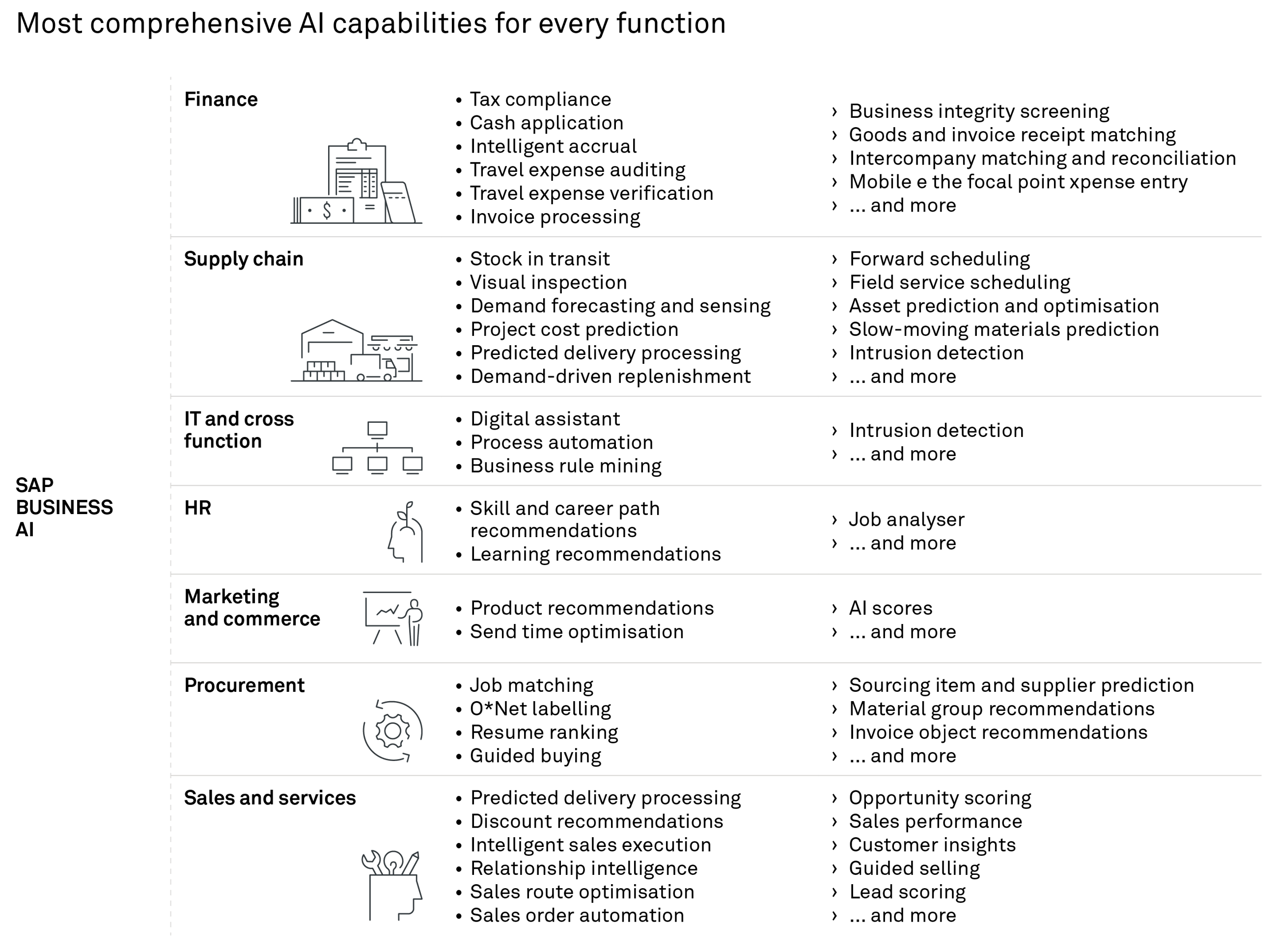Article
The strategic vision of SAP AI and what it can do for your business
Published
27 November 2024
This article outlines SAP’s vision for integrating AI, particularly generative AI, into its product suite, with significant implications for business software.
SAP is embedding AI across its portfolio, featuring a new AI assistant called “Joule” that simplifies tasks within systems like S/4HANA. The company also empowers its customers to develop AI-powered applications via the SAP Business Technology Platform. Additionally, SAP is launching its own foundation AI model tailored for complex business tasks, enhancing decision-making in areas like finance and supply chain.
As always, we advise businesses to define goals, assess data quality and explore use cases before implementing AI.
Three central concepts
- Integration of AI across SAP’s portfolio: SAP aims to embed AI, particularly generative AI, into its extensive product lineup, enhancing software usability and enabling businesses to achieve new outcomes through AI-driven functionalities.
- Introduction of the digital assistant “Joule”: SAP is launching “Joule”, an AI-powered digital assistant designed to streamline user interactions with SAP systems. Joule will simplify complex tasks, making it easier for users to access information and execute transactions efficiently.
- Empowering customers with custom SAP AI solutions: SAP provides customers with the opportunity to create their own AI applications using the SAP Business Technology Platform. This includes access to a foundation AI model tailored for business-specific tasks, enabling companies to leverage their data for improved decision-making and operational efficiency.
What is SAP’s AI vision?
AI, and most of all generative AI, will fundamentally change the way we as humans use business software. AI marks a huge paradigm shift and thus also represents interesting opportunities for new business outcomes that no one has previously been able to imagine.
As a technology mega vendor, there is little doubt that SAP sits on a gigantic customer base (24,000+ companies globally use SAP software to one extent or another), and it is therefore interesting for business leaders to follow how SAP intends to combine the AI possibilities with the processes and data that drive much of the business world and have done so since SAP was founded in 1972.
SAP’s strategy is, first and foremost, to embed AI across its entire product portfolio. This is, in itself, a huge product development task, and depending somewhat on which method is used to count, SAP’s software product portfolio counts more than 300 software products (figures from 2017), of which SAP S/4HANA is the ERP flagship product. SAP offers software products for a wide range of industries and business processes, from leading oil and gas production firms to sports teams to product- and service-based companies. In theory, this means that anyone doing business should be able to find something from SAP that can help them run their business better.
It is difficult for the authors of this article to give a complete picture of where you will encounter the AI functionality in SAP’s products due to the extensive product portfolio and because new ones are constantly being added. But the figure below shows a selection of the embedded AI use cases across the palette.
Capabilities of embedded AI in SAP products
The new digital assistant “Joule”
As part of its generative AI innovations, SAP is introducing a powerful AI-driven digital assistant called “Joule”. Joule is designed to enhance user interaction with SAP systems like S/4HANA, SAP IBP and SAP SuccessFactors by making complex tasks easier and more efficient. The assistant can summarise intricate information, write source code and much more, offering a completely new way for users to interact with SAP software.
For users of S/4HANA, this represents a significant shift. Currently, finding specific information or executing business transactions in S/4HANA can be time-consuming, but with Joule, these tasks will become faster and more intuitive. Joule’s AI capabilities will streamline workflows, allowing users to access the data and tools they need more efficiently.
According to SAP’s latest product road maps, Joule will be integrated across multiple platforms, providing consistent AI-driven assistance no matter which SAP product you are using. This marks a new era in business software usability where complex processes are simplified and users can focus on higher-value tasks. Joule promises to transform how businesses operate with SAP’s software, making it smarter and even more user-friendly.
Create your own “SAP AI apps”
In addition to the introduction of Joule and embedded AI functionality in the overall product portfolio, SAP customers also get the opportunity to create their own AI-powered extensions and AI applications via the SAP Business Technology Platform and the product SAP AI Foundation.
SAP wants to deliver reliable, secure and scalable generative AI solutions, which at the same time ensures that SAP’s customers have access to innovative generative AI providers on the market today, such as the well-known ChatGPT from OpenAI and many more. However, a separate license from the providers may be required. As an SAP customer, you will have the opportunity to design your own generative AI applications where your company’s business data is connected directly to the large language models available online. As an SAP customer, you can expect that the AI Foundation product will be a necessary investment for this connection to be established, and a license will, no matter what, be required.
SAP is set to introduce its own SAP Foundation Model, giving customers more opportunities to create AI-driven solutions across finance, sales, and supply chain operations. This model is trained on large, anonymised data sets, including proprietary foundation models and structured business data, making it uniquely suited to handle complex business-specific tasks. Unlike traditional large language models (LLMs), SAP’s foundation model can answer detailed business questions, such as “When can I expect my customers to pay their bills?” It can also recommend efficiency improvements for business processes. This tailored approach will help SAP customers unlock more precise insights and optimise their operations in ways that generic AI models cannot.
By providing this advanced AI solution, SAP enables businesses to innovate and enhance decision-making in key areas, making AI an even more integral part of everyday business operations.
Our two cents
In our view, SAP follows the AI trends that are out there.
We expect that the biggest changes to SAP systems will directly impact the business user in his or her everyday work and are very likely to also transform the way we as individuals think about business applications to appear “smarter” and provide us with more intuitive suggestions to input data, search results etc. We also believe that this development will make tedious tasks like writing complex ABAP code more enjoyable as code assistance can be provided on the fly by Joule.
However, as a business or IT leader, you should be aware of three key elements:
- First, it is going to be imperative that you optimise your data quality in your SAP systems before adopting Joule, as it will otherwise be greatly ineffective.
- Second, we recognise that it is difficult to get started with AI in general. As a CIO, you probably sit and think about which AI competencies, AI technology products and AI use cases you should go for. At the same time, SAP throws AI capabilities into all products, which does not make adoption and use case prioritisation any simpler.
- Third, there is the question of how to embrace the challenges of AI ethics. SAP takes data security and privacy in AI model training very seriously, but managing ethical compliance internally in your business may also seem challenging upfront.
Five factors to get started with SAP AI
- Align the SAP AI strategy with the overall AI strategy for your company. What is the ambition level, where do you want to start, and how should AI be governed internally?
Define clear business impact goals: whether you want to improve efficiency, automate tasks, enhance decision-making or gain predictive insights, understanding your goals will help you choose the right AI tools holistically. - Become familiar with SAP’s approach to AI to understand what it can do for your business. Learn which of the out-of-the-box AI use cases in SAP’s AI use case catalogue could be of interest to your business process or impact goals. Understand the catalogue content before you start developing your own SAP AI apps.
- Investigate which SAP AI use cases can be implemented given the state of your current SAP system landscape. Think about how SAP AI can integrate with your current business systems. Most AI solutions in SAP seamlessly connect with existing SAP infrastructure, but understanding integration points is crucial.
- Learn how SAP AI tools handle data privacy, security and regulatory compliance, particularly if you are working with sensitive business data.
- Implement the SAP AI use cases with the highest impact potential. Start by assessing data readiness. Consider how your existing data from SAP modules like FICO, Sales and Supply Chain can be leveraged. AI relies heavily on data, so assess your organisation’s data quality. Clean, well-structured data is essential for success.
By considering these five factors, you will be well-equipped to implement SAP AI effectively and leverage its potential benefits.
Any questions?
Related0 4
Article
Read more
The AI opportunity for eGovernment in Luxemborg
Adopting AI in public administration to enhance productivity and create value for citizens and businesses.Article
Read more
Digital innovation with control – Clearing the cloud
Achieving digital sovereignty in Europe.Article
Read more





